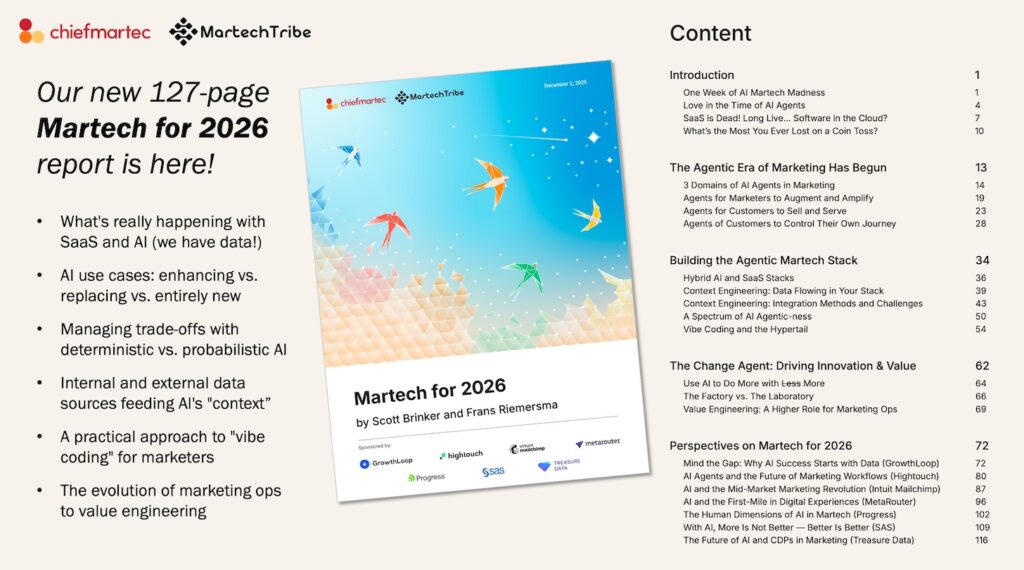I have spent most of my working life at the intersection of marketing and technology. I’ve been on both sides of the fence, with a background as a software engineer and platform architect on one side and many years of experience in product marketing (and enough corporate marketing to be dangerous) on the other. I’ve consulted separately with marketing departments and IT departments, for small start-ups and the Fortune 500.
But by far the most fascinating projects for me have been those at the nexus between these two worlds — the rapidly evolving space of marketing technology.
My passion for marketing technology can be triangulated by four pieces of writing:
(1) Nicholas Carr’s controversial Does IT Matter?. I basically agree with his premise: IT departments can be too technology focused, and IT by itself seems increasingly commoditized in the grand scheme.
That’s not to say that there isn’t great advantage to be found through technological innovation in business — there most certainly is. But it has everything to do with the business competencies enabled through that innovation, not the technology itself. Anyone can buy paint, brushes, and canvas; becoming the next Picasso is another matter entirely. In my view, there are two core areas of business competency — operations and marketing/sales — and these need to be the groups driving both the vision and the implementation of business technology.
(2) The Long Tail by Chris Anderson. The Internet has triggered a major inflection point in the arc of marketing since the Industrial Revolution, from a mass market culture — and the business models and processes that leveraged it — to an explosion of niches.
But niches don’t have to belong only to small companies. The multi-billion dollar successes of Google, Amazon, eBay have been achieved through the aggregation of niches. I believe that the future of every business, consumer or B2B, is somewhere along this continuum. The challenge for marketing technology is to let an organization master as broad a spectrum of niches as possible, with as much depth and specificity within each niche as possible.
The three drivers behind The Long Tail strike me as a checklist for all strategic marketers to harness in their space:
- democratization of innovation and production via user-generated content and participatory marketing;
- minimization of production and distribution costs in a digital environment, where variable costs may even asymptotically approach zero; this is not limited to purely digital goods either — think of the service and support surrounding industrial, physical goods;
- social networking of consumers (increasingly even B2B “consumers”) to define and amplify niches.
(3) The article Marrying IT and Marketing by Michael Fischler. “IT is the master of information. Marketing is the master of exploiting information. But … these two organizations, traditionally mongoose and cobra, are at perpetual odds with each other. Chronically battling for budget share, chronically fighting to do things their way. Chronically misunderstanding that they have the same goals.”
Fischler’s proposed solution is that these two groups be consolidated through the creation of a new organization within the enterprise: Marketing Technology, led by a Chief Marketing Technologist. This group would consist of the best and brightest from marketing and IT, technically-savvy marketers and marketing-savvy technologists. These Chimeric creatures do exist, albeit somewhat scarce today, but the Internet generation is breeding more of them.
Fischler’s article was the direct inspiration for this blog.
(4) Big Think Strategy by Bernd H. Schmitt. The reaction to the radical restructuring that Fischler proposes is often “yeah, but that’s not going to happen in my organization”. This goes straight to the heart of Schmitt’s thesis: everyone knows that businesses need creative and innovative strategies to compete, but conventional corporate wisdom — which eschews risk taking and rewards small thinking — discourages the kind of bold thinking that is needed to change markets. Big Think Strategy is the antidote to such corporate inertia.
This book is liquid inspiration for marketers and business strategists, with a wealth of examples of successful “big think” execution: the iPod, Whole Foods, Dove’s “Real Beauty” campaign, even the Trojan War. To me, big think strategy is both the goal of marketing technology and the coordinating device for elevating such a role in the leadership of an organization.
I did a Google search today for “chief marketing technologist” and was surprised to find only 345 matches. The phrase “director of marketing technology” did a little better, with 7,520 matches. My hope is that this blog will serve as a resource to help spread the “marketing technology” meme.


